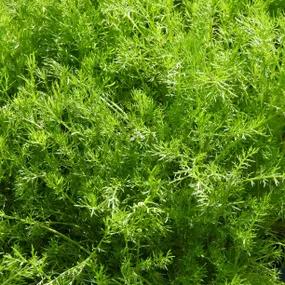Treneague Chamomile Plants
The details
Chamamaelum nobile
Pot Grown Herbs- Height: 6-10 cm
- Colour: evergreen foliage
- Uses: border edging, lawn, non-flowering
- Spacing: 20 cm
- Scent: apple/grassy
- Spread: 30 cm
- Life: hardy perennial
Recommended extras
Description
Chamaemelum nobile 'Treneague'
Treneague Chamomile is a dwarf variety with a mass of springy, mid-green fragrant foliage that flourishes all year round without the complications of flowers or a season off. Each plant will spread up to 40cm, maintaining an even height at 6-10cm of finely divided, fronded leaves that knit together. The leaves are highly scented, especially if you brush past or tread on them, and they are quite good for wildlife.
Growing Treneague Chamomile
It needs a sunny spot - a little dappled shade is fine - otherwise it develops bald patches, and a light, well drained soil; it can be poorly fertile, as long as it doesn't dry out too much in summer. Heavy clay will be too wet in winter and too dry in summer. Its dwarf nature means that it never outgrows its space.
It's a popular choice for soft, flouncy border edging, and it's good for a rockery garden: clear a little patch of stones and plant so that it forms its own little cushion of green amongst the rocks.
A Chamomile lawn
For a mow-free lawn, this non-flowering Chamomile is a fine choice, as long as there is only light pedestrian traffic. Spaced at 20cm apart, you'll need about 25 plants per square metre, and plant will interweave with the next to form a bouncy, green carpet which provides solid green coverage throughout the year. You can go as close as 10cm spacings if you want full coverage in a hurry.
Prepare the site well, thoroughly removing all weeds over a few weeks to make sure you get all the seeds (you'll regret it later if you don't) and stones. Unlike grass, where the growing point is at the bottom of the plant and mowing encourages growth, chamomile has its growing point at the tip of its shoot, so you should never mow it, unless you need to remove dead or damaged fronds to tidy up, ideally in Autumn or Winter.
Once planted, you should not walk on your Chamomile lawn for at least 12 weeks, and then as little as possible for a year so that it can properly settle in. To pep it up in spring, plant some crocus bulbs or diminutive Dianthus and creeping thyme to add floral interest - or try planting a few of the flowering types of chamomile, especially the low-growing 'Flore Pleno'.
Aphids can suck the life out of a chamomile lawn. Extremely sharp frosts will damage the leaves and might even kill the plant in the early years, so if you live in colder Northern areas, be ready to cover your chamomile with horticultural fleece. Weed by hand as much as possible; selective weedkillers for grass lawns will kill a chamomile one.
Features:
- Height: 6-10 cm
- Spread: 30-40 cm
- Colour: green foliage all year round
- Uses: border edging, lawn for light pedestrian use, rockery
- Does not flower
- Spacing: 20 cm
- Scent: grassy, a little like new-mown hay
- Habit: spreads to form a mat
- Life: hardy perennial
Did You Know?
Mary Wesley's novel The Chamomile Lawn centred on a family on holiday in Cornwall in the last peacetime summer before World War II. The chamomile lawn represented the quintessence of Englishness and something for all to long for over the coming years. Appropriately, Chamaemelum nobile was brought over by the Romans when they invaded Britain (what did they ever do for us?) and the wild form's daisy-like flowers are used for all sorts of medicinal purposes - in tea for colds like Peter Rabbit's, for insomnia and menstrual cramps, and ubiquitously in shampoo to lighten hair in eternal pursuit of that Scandi, sunkissed look.
Matricaria retutica, German chamomile, is more common and often replaces Roman chamomile in tinctures and essential oils, but it is a completely different plant and unsuited to pedestrian use.


